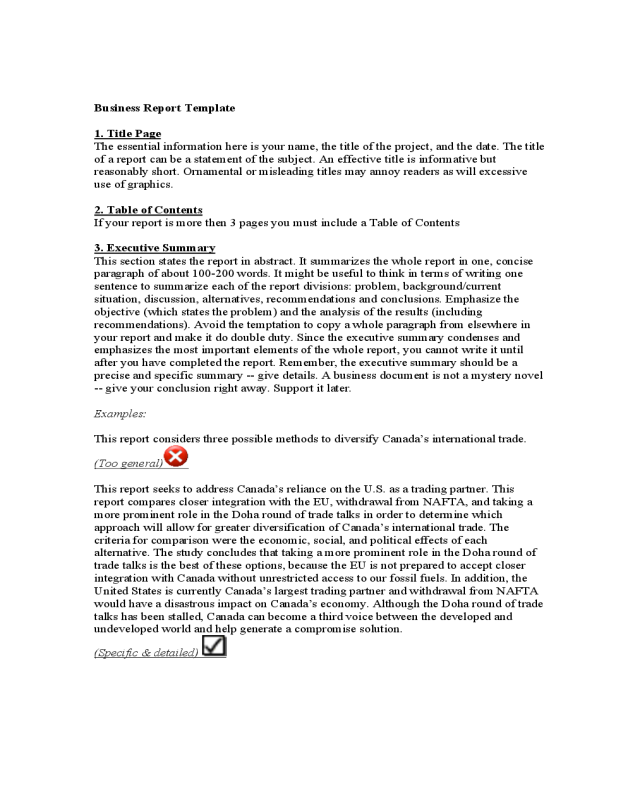Fillable Printable Basic Business Report Template
Fillable Printable Basic Business Report Template

Basic Business Report Template

Business Report Template
1. Title Page
The essential information here is your name, the title of the project, and the date. The title
of a report can be a statement of the subject. An effective title is informative but
reasonably short. Ornamental or misleading titles may annoy readers as will excessive
use of graphics.
2. Table of Contents
If your report is more then 3 pages you must include a Table of Contents
3. Executive Summary
This section states the report in abstract. It summarizes the whole report in one, concise
paragraph of about 100-200 words. It might be useful to think in terms of writing one
sentence to summarize each of the report divisions: problem, background/current
situation, discussion, alternatives, recommendations and conclusions. Emphasize the
objective (which states the problem) and the analysis of the results (including
recommendations). Avoid the temptation to copy a whole paragraph from elsewhere in
your report and make it do double duty. Since the executive summary condenses and
emphasizes the most important elements of the whole report, you cannot write it until
after you have completed the report. Remember, the executive summary should be a
precise and specific summary -- give details. A business document is not a mystery novel
-- give your conclusion right away. Support it later.
Examples:
This report considers three possible methods to diversify Canada’s international trade.
(Too general)
This report seeks to address Canada’s reliance on the U.S. as a trading partner. This
report compares closer integration with the EU, withdrawal from NAFTA, and taking a
more prominent role in the Doha round of trade talks in order to determine which
approach will allow for greater diversification of Canada’s international trade. The
criteria for comparison were the economic, social, and political effects of each
alternative. The study concludes that taking a more prominent role in the Doha round of
trade talks is the best of these options, because the EU is not prepared to accept closer
integration with Canada without unrestricted access to our fossil fuels. In addition, the
United States is currently Canada’s largest trading partner and withdrawal from NAFTA
would have a disastrous impact on Canada’s economy. Although the Doha round of trade
talks has been stalled, Canada can become a third voice between the developed and
undeveloped world and help generate a compromise solution.
(Specific & detailed)

4. Introduction/Problem Statement
a.) Whereas the Executive summary summarizes the whole report, the introduction of a
business report identifies the subject, the problem (or objective), and the plan of
development of the report. The subject is the "what", the purpose is the "why", and the
plan is the "how." Together these acquaint the reader with the problem you are setting out
to solve.
Example:
Subject: Canada’s international trade
Problem/Objective: Most of Canada’s trade is with the United States and any problems in
the U.S. have a dramatic impact on Canada. How can Canada diversify its trade?
Plan: courses of action to diversify Canada’s trade
b.) State the subject and purpose as clearly and concisely as possible, usually in one/two
sentence(s) called the thesis or problem statement:
Example:
This report describes the plan to diversify Canada’s international trade by taking a
prominent role in the Doha round of trade talks. This will limit the effects of economic
downturns and political turmoil in the United States on Canada’s economy and provide
access to many more markets for Canadian goods and services.
c.) Use the introduction to provide the reader with any special information which the
reader will need before you can launch into the body of your paper (uncommon
terminology etc.). Avoid the tendency to use the introduction merely to fill space with
sweeping statements that are unrelated to the specific purpose of your report
("Throughout the ages, human beings have looked up at the stars and wondered about
[your topic here].").
4. Background/Current Situation
This section includes a brief history of the subject and an overview of the current state of
affairs.
5. Discussion
a.) This section is the most important part of your report. It takes many forms and may
have subheadings of its own. Its basic components may include: methods, findings (or
results), and evaluation (or analysis). A business report should emphasize evaluation of
the data. Most academic assignments should also focus on your evaluation of the subject.
b.) Before you begin writing, ask the journalist's questions: who? when? where? what?
why? how? The last three in particular will help you focus analysis. Beyond asking these
simple questions, you also need to make decisions such as: How do you interpret the
data? What is the significance of your findings?
6. Recommendations / Conclusions
What actions does the report call for? The recommendations should be clearly connected
to the results of the rest of the report. You may need to make those connections explicit at
this point--your reader should not have to guess at what you mean. This section may also
include plans for how further research should proceed. In some professional business
writing, this section often comes immediately after the introduction.
7. References/Bibliography/Attachments
These will include references and may include appendices. Any research that you refer to
in the report must also appear in a list of references at the end of the work so that an
interested reader can follow up your work.
Appendices may include raw data, calculations, graphs, and other quantitative materials
that were part of the research, but would be distracting to the report itself. Refer to each
appendix at the appropriate point (or points) in your report. In industry, a company
profile and profile of the professionals involved in a project might also appear as
appendices.



